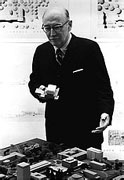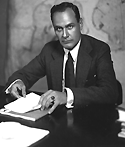 Thomas
MacKesey |
Gilmore D. Clarke ‘13 became dean in 1938. His tenure was marked by
the development of the program in City and Regional Planning. The College also began
offering courses in housing and industrial design. The regular undergraduate and graduate
courses continued, but the College also instituted two new six-year courses leading to the
degrees of Bachelor of Architecture/Master of Landscape Architecture, and Bachelor of
Architecture/Master of Fine Arts. Additionally, the College gave an undergraduate Teacher
Training degree and a graduate Regional Planning degree. In 1940 the College enrolled
130 students and had a faculty of twenty. During World War II enrollment declined. Many
students and faculty members joined the service; other faculty participated in war-related
work, filled in for faculty in other colleges, or taught in the military programs on
campus. The College planned accelerated instruction programs and a policy for returning
veterans. In 1949 the College registered a total of 248 students, the largest enrollment
in its history.
The programs expanded and advanced during the administration of Thomas W. Mackesey who
succeeded Clarke in 1950. He brought a number of outstanding faculty members to Cornell,
actively developed the graduate component, helped initiate the visiting critic program,
and launched interdisciplinary research in housing and urban development through the
Center for Housing and Environmental Studies. In 1959 the College moved into its current
home in Sibley Hall.
In the 1950s the architecture program defined itself as purely professional, but in the
broadest sense. An architect was seen as an artist and an engineer, an administrator, and
a coordinator of the work of experts in many fields. The program emphasized the
architect’s obligation to society as well as to the client. Enrollment was restricted
to sixty students per year in the architecture course, and thirty in the fine arts course.
|


